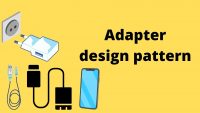in a word, The adapter design pattern is a bridge that connects two incompatible components interface
The adapter helps the classes to work together usually if the class interface differ then they won’t work together
in essence, It will change the incompatible class interface with the compatible interface

![]()
to put it differently, Suppose you have designed a component1 or application1 class which have an unrelated interface or it doesn’t match the component 2 or application2
In that case, we use an adapter class to bridge the two unrelated interface to match with each other
Real-life example
this time, Well, imagine this
in reality, Suppose you have a task to charge a mobile phone
but the problem is?
in this situation, The mobile phone support only a square-pin charger to charge it
until now, Okay
At this point, you have a two-pin charger
So, that means you have a two-pin charger which is incompatible to charge the mobile phone
as a matter of fact, Like it or not, you cannot charge the mobile phone with your two-pin charger
but Why?
Because the mobile phone support only a square-pin charger
at this time, Is it possible To charge the mobile
on the whole, yes, Absolutely
But how?
in reality, let’s see how the adapter design pattern solves the problem of two incompatible interface
not to mention, at this instance, we will introduce an adapter interface(charger) that allows you to change the two-pin interface to a square-pin interface
So, the functionality of the adapter(charger) is that it will allow two incompatible interfaces to work together
finally, you can charge the mobile phone by using the adapter
all in all, pretty effective right?
let’s deconstruct the words that we use during the adapter design process
in the first place, the client is your two-pin charger
in the second place, the adapter is a charger that converts the two-pin interface to square pin interface
in the third place, the adaptee is the square-pin charger
up to the present time, clear as mud?
Structure

#include <iostream>
using namespace std;
class MobileInterface // Interface of Adaptee
{
public:
virtual void Square_pin() = 0;
};
class MobilePhone : public MobileInterface // Concrete Adaptee
{
public:
void Square_pin() {
cout << "The phone only supports a Square pin charger" << endl;
}
};
class AdapterInterface // Target, the interface of Adapter which client will use
{
public:
virtual void Two_pin() = 0;
};
class Adapter : public AdapterInterface
{
private:
MobileInterface *mobile_interface;
public:
Adapter(MobileInterface *obj) {
mobile_interface = obj;
}
void Two_pin() {
mobile_interface->Square_pin();
}
};
int main()
{
MobilePhone *mobilephone_ptr = new MobilePhone();
AdapterInterface *adapter = new Adapter(mobilephone_ptr);
adapter->Two_pin();
}Output
The phone only supports a Square pin chargerof course, for this adapter design pattern you can assume the client as the main function
for instance, the above program has two interfaces called mobile interface and adapter interface and two classes called mobile phone and Adapter
this time, The adapter class contain a function called two-pin()
Line 31: mobileinterface is taken as an input object
Line 32: using this obj you can call the function line 36
Line 42:object called mobilephone is created
Line 43:the created object is passed to the adapter
Line 43: the pointer *adapter is pointing to an adapter class
Line 44: by using this adapter pointer you can call the function of line 35


I read your post, and I loved it. Thanks. A try from my side.
Is this a correct adapter pattern?
class Socket {
public:
virtual void electricitySource() = 0;
};
class EuropeanSocket : public Socket {
public:
void electricitySource() { cout << "Electricity from EuropeanSocket socket!" << endl; }
};
class IndianSocket : public Socket {
public:
void electricitySource() { cout << "Electricity from IndianSocket socket!" <socket = socket;
}
void electricitySource() {
socket->electricitySource();
}
};
// European Client.
class ElectricKettle {
EuropeanSocket* socket;
public:
void plugIn(EuropeanSocket* socket) {
this->socket = socket;
}
void boil() {
socket->electricitySource();
cout << "Kettle is ON!" <plugIn(eSocket);
kettle->boil();
// You travelled to India.
// E.g. India has 3-pin socket.
IndianSocket *iSocket = new IndianSocket;
// Use adapter for compatibility.
Adapter* adapter = new Adapter(iSocket);
kettle->plugIn(adapter);
// Let’s boil.
kettle->boil();
return 0;
}